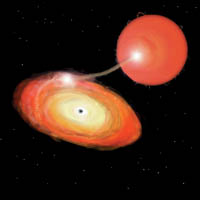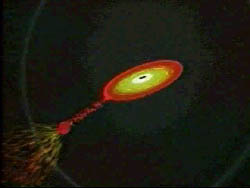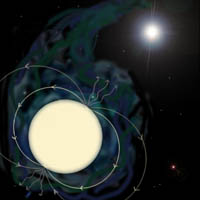Imagine the Universe News - 30 May 2002
Going, going, almost gone: Pulsar whittles away stellar companion to planet-size
| 30 May 2002 |
 |
| An artist's conception of an X-ray pulsar in a binary star system. Matter from a companion star channels onto a rapidly spinning neutron star at its magnetic poles. (Click image for larger view.) (Image credit: M. Masetti, NASA/GSFC) |
Scientists at the Massachusetts Institute of Technology have found a pulsar in a binary star system that has all but completely whittled away its companion star, leaving this companion only about 10 times more massive than Jupiter.
The system has one of the lowest-mass companions of any stellar binary. The finding provides clear evidence that neutron stars can slowly "accrete" (i.e., steal) material from their companions. In doing so, the spin rate of the neutron star increases dramatically. The system ultimately evolves into an isolated, radiowave-emitting pulsar spinning a thousand times per second - the type commonly seen scattered throughout the Milky Way galaxy. It is rare, however, to find a such a fast spinning pulsar still accreting material from its companion.
The maligned companion, once a bright orange gem probably more than half the mass of our Sun (equivalent to 500 times the mass of Jupiter), has slowly grown dimmer and dimmer and will eventually vanish without even a whimper.
This pulsar was discovered by Dr. Ron Remillard of the MIT Center for Space Research along with Drs. Jean Swank and Tod Strohmayer of NASA Goddard Space Flight Center. The X-ray source, named XTE J0929-314, was found in mid May, 2002, during a routine survey of the sky with NASA's Rossi X-ray Timing Explorer. Dr. Duncan Galloway, a postdoctoral associate at MIT, performed the follow-up observation that revealed the pulsar system's unique properties. Other members of the MIT observation and analysis team include Dr. Edward Morgan and Professor Deepto Chakrabarty.
"This pulsar has been accumulating gas donated from its companion for quite some time now," said Galloway. "It's exciting that we are finally discovering pulsars at all stages of their evolution, that is, some that are quite young and others that are transitioning to a final stage of isolation."
 |
| This video shows the fate of certain binary star systems with a neutron star. One star, several times more massive than the Sun, experiences a core collapse, which produces a neutron star. This neutron star slowly accretes matter from its companion star, spinning faster as it absorbs that star's rotational energy. Scientists say that such neutron stars cannibalize their companions, becoming isolated millisecond pulsars. (Click on image for video - 9.5 MB) (Credit: NASA) (Description) |
Neutron stars in "low mass" binary star systems such as the one observed here (where the companion has less mass than the Sun) have been suspected as the sites where slowly spinning neutron stars are spun-up to millisecond spin periods. A neutron star has a powerful gravitational field, and it can accrete gas from its companion. Matter spirals toward the neutron star in the form of an accretion disk, a journey visible in X-ray radiation. In doing so, it transfers its orbital energy to the neutron star, making it spin faster and faster, in this case, 185 times per second.
In the XTE J0929-314 system - only the third known "accreting" millisecond pulsar of its kind and the second identified with the Rossi Explorer in the past two months - the pulsar orbits its companion every 43 minutes. In fact, the entire binary system would fit within the orbit of the Moon around the Earth, which takes a month, making this one of the smallest binary orbits known.
While the first two accreting, millisecond pulsars discovered lie near the direction of the galactic center, the latest discovery lies in a completely different direction. "One advantage of XTE J0929-314," notes Morgan, "is that observations are less affected by crowded star fields and interstellar gas and dust."
 |
| This image shows strong magnetic fields running in loops from pole to pole. Radiation in the form of X-rays appears to pulse on and off as hot patches of gas are exposed at the poles with the neutron star's rotation. (The axis of rotation is different from the axis of the magnetic field.) (Art Credit: NASA) |
"This binary system is a rare find", says Chakrabarty, who works extensively on neutron stars in the Galaxy. "It will help us to understand the link between slow-spinning pulsars in binary systems, which are quite common, and fast-spinning isolated pulsars, which are commonly seen by radio astronomers."
With XTE J0929-314 and its 10-Jupiter-mass companion, MIT scientists have stumbled upon a pulsar that may be further along its path to becoming isolated. The companion will eventually vanish as a result of both the force of gravity pulling matter onto the neutron star (accretion), and the pressure from the resulting X-ray radiation emitted from the neutron star blowing matter away from the companion (ablation).
Also, this is one of the faintest transients yet discovered with the Rossi Explorer's All-Sky Monitor. "It was found by superposing on the sky the thousands of snapshots that our three panning cameras provide in a given week of observations," said Remillard. "The results demonstrate the value of this analysis exercise and the fact that important science is not confined to the sources with the brightest or most dramatic outbursts."
The Rossi Explorer's All-Sky Monitor is an instrument designed and constructed at MIT. Follow-up observations were made with the Rossi Explorer's Proportional Counter Array instrument, which was built by a team at NASA Goddard.

